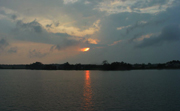 |
||
|
||
Gunk- Holin’
|
 |
|
We’re not done with Dun Cove and will certainly visit again. |
by Alice Snively
Dun Cove on Harris Creek
A beautiful place to layover for a day or two and convenient for access back into the Choptank and its many other interesting and scenic tributaries.
It wasn’t a hurricane that drove us into Dun Cove, but a couple of nasty squalls battered us as we made our way into the mouth of the Choptank River on the Eastern Shore. We had just passed the southern end of Tilghman Island when the weather started to go south. Our best bet was to head up Harris Creek, so we swung to port and fought our way up to this lovely protected cove.
In fact, whether you are coming into the Choptank the way we did or through Knapps Narrows, Harris Creek offers a number of beautiful and secure anchorages.
For several good reasons, Dun Cove is the most popular stopover on Harris Creek. It is the closest protected location after passing through Knapps Narrows. With two branches, both with good holding, it’s spacious enough for several boats to anchor comfortably. And it’s nicely protected by tree-lined shores.
Don’t Be Out of Your Depth
Before I get to the getting-there part, this is a good time to talk about a very important piece of gunkholing equipment: the depth finder. Most boats have them, but it’s crucial when navigating shallow waters to know exactly how to read them.
You need to know where on your boat the sensor is located. If it’s located below and not at the waterline, your depth finder will be showing less water than you actually have below you by the distance that the sensor is below your waterline. Some depth finders may be pre-calibrated for this difference. If your equipment is original, find out if it has been.
It’s also important to keep the sensor clean of debris. Areas with a lot of underwater plant growth can gunk up the sensor and give you readings that will make you wonder who’s hallucinating — you or your instrument. Chances are it’s the instrument, and this can increase your chances of accidental grounding.
Git’er Dun …
To make a play on Larry-The-Cable-Guy’s favorite line, getting to Dun Cove is fairly simple if you study your chart ahead of time and stay mindful of markers and depths. If you pass through Knapps Narrows from the Bay side, travel toward the Red 2 marker, which will be in front of you and just to port. Watch your depth and turn to port to head up the creek.
Look for the Red 4 day marker to starboard less than a mile ahead and stay fairly close to it. The navigable channel narrows in this portion of the creek, and shoals bring the depth down to one and two feet on either side. Slow your speed and keep a very close eye on your depth finder along the way.
Almost immediately ahead of the Red 4 day marker will be the Green 4, which you need to keep on your port side, watching your depth.
On the charts, this piece of the passage toward the Green 4 is obvious and looks a bit like a dog-leg.
Once past the green marker, you can begin to move to port toward the Red 6 day marker, keeping it well to starboard as there is a very shallow spot in the center of the channel in that area. Ahead of you will be the Green 7 marker, which is on the far side of the cove. Turn to port before you reach this marker, staying in the center of the cove entrance to avoid shoals that project from each side.
Once inside the mouth of the cove, you will easily find good anchorage. The northern branch of the cove is popular because it’s slightly more protected, but the southern branch is just as good for holding and will probably offer more seclusion. Each branch has an average of eight feet of water, so you can drop your hook just about anywhere as long as you don’t go too close to shore. The property surrounding the cove is all privately owned, so don’t plan to go exploring ashore.
This is a really beautiful place to layover for a day or two and convenient for access back into the Choptank and its many other interesting and scenic tributaries.
One final note: We don’t recommend Knapps Narrows for sailboats unless they are shoal draft. Recent reports indicate that it needs dredging again, and several sailboats have had difficulty there. To be on the safe side, take the long way around the south of Tilghman Island to enter the Choptank, then proceed north to Harris Creek.
We’re not done with Dun Cove and will most certainly visit again. If you’re in that neighborhood, do drop in.
© COPYRIGHT 2004 by New Bay Enterprises, Inc. All rights reserved.
